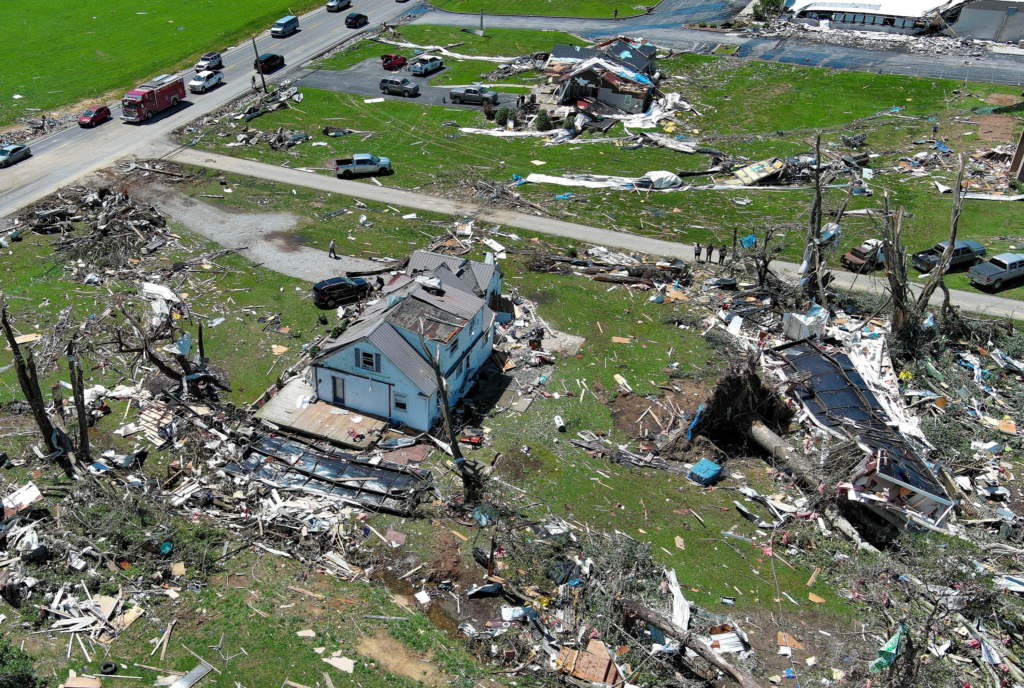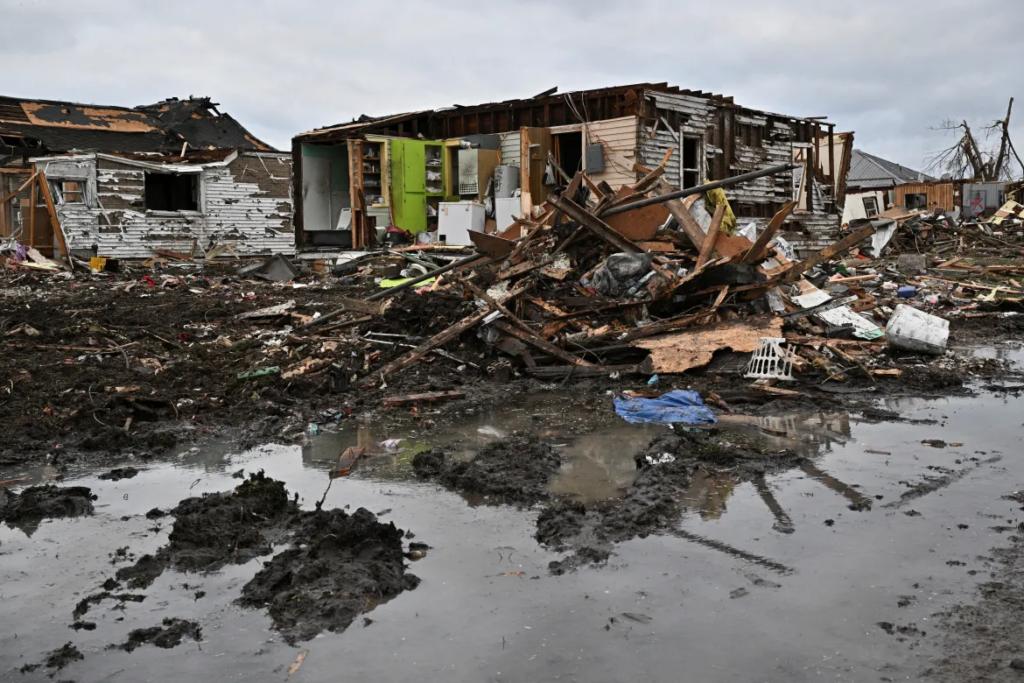Severe storms and powerful tornadoes swept through several U.S. states this week, leaving behind a trail of destruction, damaged homes, and heartbreaking loss. The deadly weather system struck parts of Texas, Oklahoma, Missouri, and Kentucky, prompting urgent evacuations, emergency rescues, and widespread power outages. Officials have confirmed multiple injuries, with some fatalities being reported as the full impact continues to unfold.
The National Weather Service issued dozens of tornado warnings and severe storm alerts throughout the affected regions, urging residents to seek shelter immediately. Entire communities are now facing the aftermath, dealing with the emotional and physical damage caused by the storms.
Worst-Hit Areas Face Catastrophic Damage
Cities like Tulsa (Oklahoma), Little Rock (Arkansas), and Paducah (Kentucky) saw some of the most severe impacts, with tornadoes flattening buildings, uprooting trees, and flipping vehicles. In Texas, parts of the Dallas-Fort Worth metroplex were pounded by baseball-sized hail, damaging hundreds of vehicles and homes.

In Oklahoma, a large wedge tornado reportedly stayed on the ground for over 45 minutes, carving through neighborhoods and tearing roofs off houses. Videos shared on social media show entire blocks turned into rubble, with emergency workers navigating the chaos to rescue trapped residents.
Missouri Governor Mike Parson declared a state of emergency, stating, “The destruction is widespread, and our priority is to get aid to families as fast as possible.”
Communities Left Without Power and Clean Water
Utility companies reported over 500,000 outages across affected states, with downed power lines and broken transformers making repairs challenging. Some towns remain without clean water and are relying on temporary relief shelters and bottled water provided by FEMA and the Red Cross.
Local authorities have set up shelters for displaced residents, with schools, churches, and community centers stepping up to offer food and safe housing. In Paducah, one resident, Laura Jenkins, shared, “I’ve never seen anything like this. One moment we were having dinner, and the next, the roof was gone.”
First Responders Work Around the Clock
Emergency responders, firefighters, and volunteers are working tirelessly across states to clear roads, search for survivors, and deliver aid. National Guard units have been deployed to assist with rescue operations and prevent looting in hard-hit areas.
Medical teams have also been dispatched to overwhelmed hospitals treating storm-related injuries ranging from fractures to hypothermia. According to the American Red Cross, mobile units are being sent to rural communities that have limited access to emergency services.
Weather Experts Warn of Continued Threat
Meteorologists are warning that the threat is not over yet. The current weather pattern is expected to persist, with more thunderstorms and the risk of additional tornadoes through the weekend.
The National Weather Service emphasized that the unusual heat and moisture levels across the South and Midwest are contributing to this highly unstable weather system.
Dr. Karen Monroe, a storm expert from NOAA, said, “We are seeing more frequent and intense storm systems, which is likely connected to broader climate patterns.”

Residents are urged to monitor their local weather stations, sign up for emergency alerts, and have a safety plan in place.
For real-time updates and safety information, visit www.weather.gov
Local Governments Appeal for Federal Assistance
State leaders from Kentucky, Missouri, and Texas have appealed to the federal government for disaster declarations. This would unlock emergency funds, support for rebuilding efforts, and access to national aid programs.
In a press conference, Kentucky Governor Andy Beshear said, “The people of our state are resilient, but we cannot do this alone. We need the full support of FEMA and federal resources to rebuild.”
President Biden has expressed concern and promised federal support, stating the administration is closely monitoring the situation and ready to assist in every way possible.
Stories of Survival and Solidarity
Amid the devastation, stories of survival and community spirit are emerging. In Arkansas, a school janitor reportedly saved a group of students by guiding them into a storm-safe room just moments before the building was struck.
In Missouri, neighbors banded together with chainsaws and trucks to clear roads and check on elderly residents. Churches and local charities are delivering meals, blankets, and first-aid kits to families who lost everything.
These powerful stories are shining a light on human resilience, even in the darkest hours.
Long Road to Recovery Ahead
While rescue efforts are still ongoing, the recovery phase is expected to take weeks, if not months. Thousands of homes are damaged or destroyed, businesses are closed, and livelihoods have been disrupted.
Insurance claims are already in the millions, and rebuilding efforts will require not just funds, but also community cooperation and mental health support.
Mental health professionals are encouraging families, especially children, to seek counseling as trauma-related stress is likely to increase in the coming weeks.
How You Can Help
Several organizations are accepting donations to aid storm victims:
Even small donations can help supply food, water, shelter, and medical care to those in desperate need.
Final Thought
Severe weather continues to be a growing threat to American communities. As the climate shifts and storms intensify, preparedness, cooperation, and swift emergency responses remain more crucial than ever.
Stay informed. Stay safe. And when disaster strikes, stand with those who need us most.
Also Read – Why Scientists Are Marching Again in 2025 – Explained






